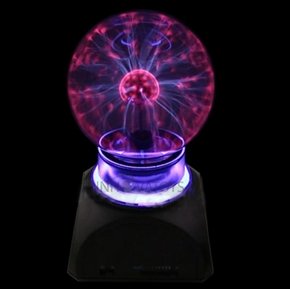Plasma Ball

A plasma ball is a sealed glass globe containing an inert gas inside. The gas most commonly used is neon, sometimes combined with other inert gases such as argon, xenon, and krypton. The gas inside the globe is typically at a pressure close to atmospheric pressure. This gas is highly energized, using electricity, which causes it to become a plasma state. This plasma appears to us as a colorful display of filaments moving around inside the glass globe. The light emitted by the highly energized gas depends on the type of gas used. The type of filaments created, whether more lightning-like, or fuzzy streamer-like, also depend on the type of gas used.
Check out a video of a plasma ball:
When atoms of a gas are highly energized, they heat up to a very high temperature. This causes the electrons to break free from the parent atoms of the gas. The parent atoms then become positively charged ions as a result (since they are missing electrons, which are negatively charged). This combination of highly energized (positively charged) ions and (negatively charged) electrons is like a "soup" which we call plasma.
Inside the plasma ball there is an electrode in the shape of a ball. The reason the gas inside the globe is chosen to be inert is to prevent it from reacting with the electrode surface during operation. During operation, the electrode is negatively charged with a high voltage of 2-5 kilovolts. This voltage is made to oscillate at a high frequency of about 35 kilohertz, which in turn generates oscillating current. The high voltage causes the gas to break down and conduct electricity, and the high frequency enables the current (flow of electrons) to pass through the glass and into the surrounding air by a process called "capacitive coupling". The electrons, which carry a negative charge, are attracted to the earth, which has a neutral charge. If you touch the globe with your hand, you are creating an easier pathway for the electrons to travel, which is why the filaments move to the location of your hand, as this provides an easier path for the electrons to reach the earth (by passing through your body).
In addition, the plasma ball creates an electromagnetic field, due to the oscillating electrons. To test this out, bring a fluorescent light tube near the plasma ball, without touching it. The electromagnetic field causes the electrons inside the light tube to oscillate as well. These moving electrons constitute an electric current, which causes the tube to light up the way it normally would inside a light fixture. You can also cause the tube to light up by touching the plasma ball with it. In this case, the electrons flow through the tube, through you, and into ground. The flow of electrons through the tube causes it to light up.
Here's another cool video of a plasma ball:
Return to Science Toys page
Return to Real World Physics Problems home page
Free Newsletter
Subscribe to my free newsletter below. In it I explore physics ideas that seem like science fiction but could become reality in the distant future. I develop these ideas with the help of AI. I will send it out a few times a month.